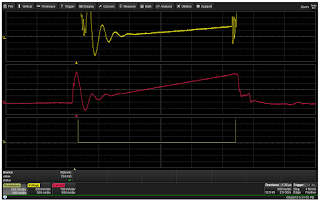 |
Figure 1: Setup for analysis of switching losses
in a switch-mode power supply's MOSFET
|
Our survey of testing switch-mode AC-DC power supplies started by looking at the
variety of measurements one might make on these devices and why differential probes and amplifiers are often the best choice over passive probes. Subsequently, we examined the key
sources of error in power-supply measurements and how to minimize them. Now it's time to start taking some measurements with an eye toward device analysis, particularly the switching transistor in a switch-mode supply.
Most modern digital oscilloscopes will provide the requisite capabilities to analyze such devices, but some are particularly well suited for the task due to dedicated software and UIs tailored to the job at hand. Teledyne LeCroy's
Power Analyzer software is one such example; some of the discussion to follow keys in on that software.
Figure 1 depicts a detail of the setup for measuring the source-to-drain voltage of the MOSFET switch. A current probe is also attached at the location of the top probe to measure current as well as for calculating power.
 |
Figure 2: Voltage, current, and power traces are shown
for a switch-mode power supply |
Figure 2 shows an example of the voltage, current, and power waveforms one might obtain from a representative switch-mode power supply. Annotations in the image highlight the various stages of the MOSFET's operation: turn-on, turn-off, conduction, and off-state. When the voltage trace is at zero, we can see the pink current trace rising as the switch closes. When the switch opens, the voltage jumps back up, we stop conducting current, and the device goes into its off-state. At the bottom of the screen, the Power Analyzer software displays the switching losses for each state as well as the sum of the losses.
One may also have the losses displayed in Joules or energy. The software performs an integration of the power waveform for each state to calculate their respective energy losses. Dividing those energy loss figures by their duration in time yields the power losses for each state. These figures provide a window into the power supply's efficiency. Not only does it give the total loss per switching cycle, but it also gives the losses for each state. It shows exactly where in the switching cycle excessive losses are incurred.
 |
Figure 3: Using a differential amplifier with fast overdrive
recovery makes for accurate on-resistance measurements |
Another important parameter of a switching MOSFET is its on-resistance, or R
DSon. Using a good differential amplifier, such as Teledyne LeCroy's
DA1855A, makes such measurements easier and more accurate. Because the DA1855A offers excellent overdrive recovery, the MOSFET's signal can be overdriven off the screen while the vertical timebase is used to zoom in on the section of interest. Generally speaking, using this technique on the oscilloscope itself will saturate the instrument's front end amplifier; recovery takes some time. The DA1855A lets you overdrive the signal without concern for errors when it comes back on-screen.
As a result, you can achieve very good detail on saturation voltage. Referencing Figure 3, with current and voltage measurements in hand, calculating R
DSon is a simple Ohm's Law problem. The Power Analyzer software automatically calculates the on-resistance, and in the case shown here, the result is 724 mΩ.



No comments:
Post a Comment